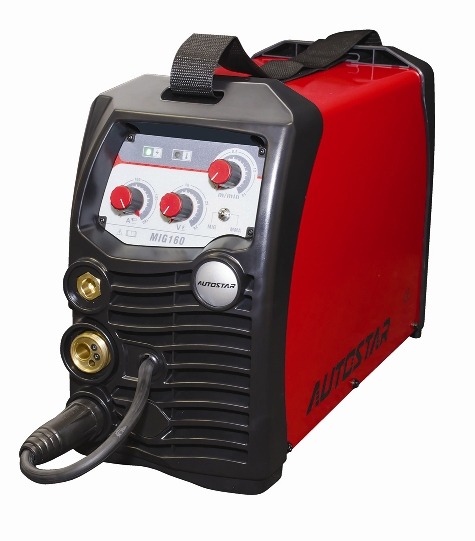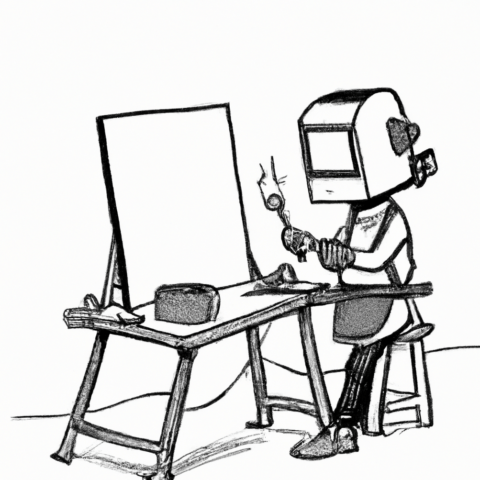Welding is not just a skill reserved for construction sites or automobile repair shops. It’s also a form of art, a creative outlet that allows artists to mold and shape metal into extraordinary sculptures and designs. As an aspiring metalwork artist, understanding the basics of welding can open up a new world of artistic possibilities.
However, when welding to create art. It’s important to understand and respect the tools and processes involved. Safety is paramount in welding, as improper handling of equipment can lead to serious injuries. Therefore, before you start creating your metal masterpieces, it’s crucial to familiarize yourself with the necessary tools, safety gear, and proper attire required for welding.
In this article, we will guide you through the basics of getting started in welding as a metalwork artist. From the essential tools and equipment to safety precautions and workspace setup, we’ll provide you with the knowledge you need to embark on your welding journey. So, let’s ignite the torch and start our exploration into the world of welding art.
In this guide:
Welding, in its most basic form, has been around for thousands of years. Early blacksmiths used simple tools and the heat of a forge to join pieces of metal together, creating everything from practical items like tools and horseshoes to ornamental pieces of art. Over the centuries, the techniques and tools used in welding have evolved, but the core principle remains the same: using heat to fuse metal.
In the realm of art, welding has found a special place. Metalwork artists use welding to create sculptures, jewelry, furniture, and other artistic pieces. The strength and durability of metal, combined with the flexibility provided by welding, allows artists to bring their most imaginative designs to life.
There are several types of welding techniques, each with its own set of advantages and applications. Some of the most common include MIG (Metal Inert Gas) welding, TIG (Tungsten Inert Gas) welding, and stick welding. As a beginner, you’ll likely start with MIG welding, which is known for its simplicity and versatility.
MIG welding uses a wire welding electrode on a spool that is fed at a constant speed through a welding gun. As the wire is being fed, it forms an arc with the metal, which melts the wire and joins the two pieces of metal together. This process is relatively easy to learn and can be used on a wide variety of metals, making it a great starting point for aspiring metalwork artists.
Essential Tools and Equipment for Welding Art
As you embark on your journey into the world of welding, there are a few essential tools that you’ll need to get started. These tools will form the foundation of your welding setup, allowing you to create a wide variety of art pieces.
MIG Welder: A MIG welder is a versatile tool that’s perfect for beginners. It’s relatively easy to use and can be adjusted to weld steel and stainless steel anywhere from 18 gauge up to 3/8” thick. This range of capabilities means you can work with a variety of materials and thicknesses, giving you the flexibility to create diverse art pieces. If you’re starting on a budget, look for a welder that can run on 230v, which should provide enough power for most beginner projects and run on a home power supply in the UK (In the US look for a 110v welder)
The Autostar MIG 160 Compact Inverter Package is a welding machine that stands out as an excellent choice for beginner metalwork artists. Its features and specifications are designed to provide a user-friendly experience while offering the versatility and performance needed for a wide range of art projects. Here’s why this welder is a great fit for beginner artists:
- Compact and Portable: The Autostar MIG 160 is a compact and lightweight machine, weighing only 12.5 Kg. This makes it highly portable and ideal for artists who may need to move their equipment around or work in different locations. Its compact size also makes it a good fit for smaller workspaces.
- Versatile Welding Options: This machine can weld steel, stainless steel, aluminum, and flux-cored wire, making it versatile enough to handle a wide variety of art projects. Whether you’re creating a steel sculpture or an aluminum decorative piece, this machine has you covered.
- Easy to Use: The Autostar MIG 160 features digital controls that make it easy to set up and use. This is a significant advantage for beginners who may not be familiar with the intricacies of welding machines. The ease of use allows artists to focus more on their creativity and less on wrestling with complicated settings.
- High Duty Cycle: With a duty cycle of 35% at 160A, this machine can handle extended use without needing to cool down. This high duty cycle is ideal for artists who work on larger projects or spend long periods welding.
- Low Input Power Requirement: Despite its high performance, the Autostar MIG 160 has a low input power requirement. This means it can operate on a standard 230V power supply, making it convenient for use in most locations.
- Complete Package: The Autostar MIG 160 comes as a complete package, including a power source, MIG torch, gas regulator, and work return lead & clamp. This means you’ll have everything you need to start welding right out of the box.
If you need a more detailed explanation of welder features then please take a look at our welding machine buyers guide.

Autostar MIG 160 Compact Inverter Package
- Input Voltage: 230V
- Pulse/Non Pulse: Non Pulse
- Duty Cycle: 35% @ 160A
- Amperage:: 25-160A
- Cooling: Air Cooled
- Wire Reel Capacity: 5 Kg wire spools
- Welding Process: MIG/MAG
- Max Wire Thickness: 0.8mm
Angle Grinder: An angle grinder is another versatile tool that’s essential for any metalwork artist. With an angle grinder, you can cut, smooth, deburr, clean, and texture your material, making it an invaluable tool in your workshop. You can use a cutoff wheel to cut your material, a sanding disk to smooth and deburr your material, and a wire cup brush to clean and texture your material.
These two tools, a MIG welder and an angle grinder, are the basics you’ll need to start creating your own metalwork art. They offer a wide range of capabilities and are relatively easy to use, making them perfect for beginners.
Remember, starting your journey into welding doesn’t mean you need to have all the tools and equipment at once. Depending on your budget and workspace, you can start with these essentials and gradually add more tools as you progress and as your projects demand. The most important thing is to start with what you have and learn the craft. As your skills grow, so too can your collection of tools and equipment.
Safety Gear and Proper Attire
As you venture into the world of welding, it’s crucial to remember that safety should always be your top priority. Welding involves high temperatures and bright lights that can cause serious harm if not handled correctly. Therefore, before you start welding, it’s essential to equip yourself with the right safety gear and attire.
- Jeans and Long Sleeve Cotton Shirt or Fire-Resistant Shirt or Jacket: When welding, sparks and hot bits of metal can fly off and land on your clothing. Therefore, it’s important to wear clothing that can protect you from these hazards. Jeans and a long sleeve cotton shirt or a fire-resistant shirt or jacket are good choices.
- Leather Boots: Similar to your clothing, your footwear should also provide protection. Leather boots are recommended as they can withstand sparks and hot metal better than other types of footwear.
- Gloves: Welding can generate a lot of heat, so it’s important to protect your hands and wrists with suitable gloves. Look for welding gloves that offer heat resistance and cover your hands and wrists completely.
- Protective Eyewear: Protective eyewear, such as safety goggles or spectacles, will protect your eyes from sparks generated when using the angle grinder, however when welding you’ll also need a welding mask to protect your eyes from the bright light.
- Fire Extinguisher: Always have a fire extinguisher nearby when welding. In case any sparks ignite a fire, you’ll be able to respond quickly.
- Welding Mask or Hood: A welding mask or hood with at least a lens shade 10 will protect your face and eyes from the bright light produced by welding. It’s one of the most important pieces of safety equipment for any welder. Use our welding lens shade guide to help select the right lens shade for your welding activity, or invest in an auto darkening helmet.
Setting Up Your Workspace
Having a dedicated and well-organized workspace is crucial for any metalwork artist. It not only provides a safe and efficient environment for your creative process but also enhances your productivity and the quality of your work. Here are some tips on setting up your workspace for welding:
- Metal Workbench: At the heart of your workspace should be a sturdy metal workbench. This will serve as your primary work area where you’ll perform most of your welding tasks. The workbench should be made of metal to withstand the high temperatures associated with welding. It should also be stable and spacious enough to accommodate your projects and tools.
- Proper Lighting: Good lighting is essential in a welding workspace. It allows you to see your work clearly, reducing the risk of mistakes and accidents. Consider installing overhead lights and having a portable lamp for detailed work.
- Ventilation: Welding can produce fumes that are harmful if inhaled. Therefore, it’s important to ensure your workspace is well-ventilated. This could be natural ventilation from windows and doors, or you could install an exhaust fan or fume extraction system.
- Organized Tool Storage: Keep your tools and equipment organized and within easy reach. This not only makes your workspace more efficient but also reduces the risk of accidents. You could use toolboxes, shelves, or pegboards to store your tools.
- Fire Safety: Given the nature of welding, fire safety should be a top priority in your workspace. Keep flammable materials away from your work area and have a fire extinguisher readily available.
- Noise Control: Welding can be noisy, which could be a problem if you’re in a residential area. Consider ways to minimize noise, such as using noise-reducing screens or doing your noisiest work at reasonable hours.
Remember, your workspace is like your personal studio. It should inspire creativity while also promoting safety and efficiency. Take the time to set it up properly, and it will serve you well as you explore the art of welding.
Getting Started with Your First Welding Project
Once you’ve equipped yourself with the necessary tools and safety gear and set up your workspace, you’re ready to embark on your first welding project. Here are some steps to guide you through this exciting process:
- Choose a Simple Project: For your first welding project, it’s best to start with something simple. This could be a small sculpture, a piece of furniture, or a simple tool. The goal is to familiarize yourself with the welding process and your equipment, so don’t worry too much about creating a masterpiece at this stage.
- Plan Your Project: Before you start welding, take some time to plan your project. Sketch out your design, noting the dimensions and the materials you’ll need. This will give you a clear roadmap to follow and will help you avoid mistakes.
- Prepare Your Materials: Once you have your plan, prepare your materials. This might involve cutting metal to the right size using your angle grinder, cleaning the metal with a wire brush, or setting up your workbench.
- Start Welding: With your materials prepared, you’re ready to start welding. Remember to follow all safety precautions, and don’t rush. Take your time to ensure your welds are strong and neat.
- Inspect and Clean Up: After you’ve finished welding, inspect your work for any mistakes or weak welds. Use your angle grinder to clean up your welds and smooth any sharp edges.
- Reflect on Your Work: Finally, take some time to reflect on your work. What did you do well? What could you improve? What did you learn? This reflection will help you improve your skills for your next project.
Remember, the goal of your first welding project is to learn and gain experience. Don’t be discouraged if things don’t go perfectly. With practice and patience, you’ll improve your skills and be creating beautiful metalwork art in no time.
Expanding Your Skills and Equipment
As you continue your journey in welding, you’ll find that your skills and needs will evolve. You may find yourself wanting to take on more complex projects, experiment with different materials, or try new welding techniques. Here’s how you can expand your skills and equipment to meet these new challenges:
- Practice Regularly: The key to improving your welding skills is regular practice. Try to set aside time each week to work on your welding projects. The more you weld, the more comfortable you’ll become with the process and the better your results will be.
- Take on More Complex Projects: Once you’re comfortable with basic welding projects, challenge yourself with more complex designs. This could involve working with different types of metal, creating larger pieces, or incorporating more intricate details into your work.
- Learn New Techniques: There are many different welding techniques, each with its own advantages and applications. As you gain experience, consider learning new techniques such as TIG welding or stick welding. This will expand your capabilities and allow you to take on a wider range of projects.
- Invest in Additional Equipment: As your skills and needs grow, you may find that you need additional equipment. This could include a more powerful welder, different types of grinders or cutting tools, or specialized safety equipment. Remember to always prioritize safety when investing in new equipment.
- Join a Welding Community: One of the best ways to learn and improve is by joining a community of fellow welders. This could be a local welding class, an online forum, or a social media group. These communities can provide valuable advice, feedback, and inspiration.
Remember, becoming a skilled welder is a journey. Don’t rush the process. Take the time to learn, practice, and gradually expand your skills and equipment. With patience and persistence, you’ll become a proficient metalwork artist capable of creating beautiful and intricate pieces of art.
Embarking on your journey into the world of welding as a metalwork artist is an exciting endeavor. It’s a journey that combines creativity with technical skill, resulting in the creation of unique and beautiful pieces of art. As you start this journey, remember that the key to success lies in understanding the basics, prioritizing safety, and practicing regularly.
Welding is not just about joining pieces of metal together; it’s about bringing your artistic visions to life. It’s about transforming raw materials into something meaningful and beautiful. And while the process can be challenging, the results are incredibly rewarding.
Remember, every great welder started where you are now – at the beginning. With time, patience, and dedication, you’ll gain the skills and confidence you need to create stunning metalwork art. So ignite your torch, put on your safety gear, and let your creativity shine. Welcome to the world of welding art.




